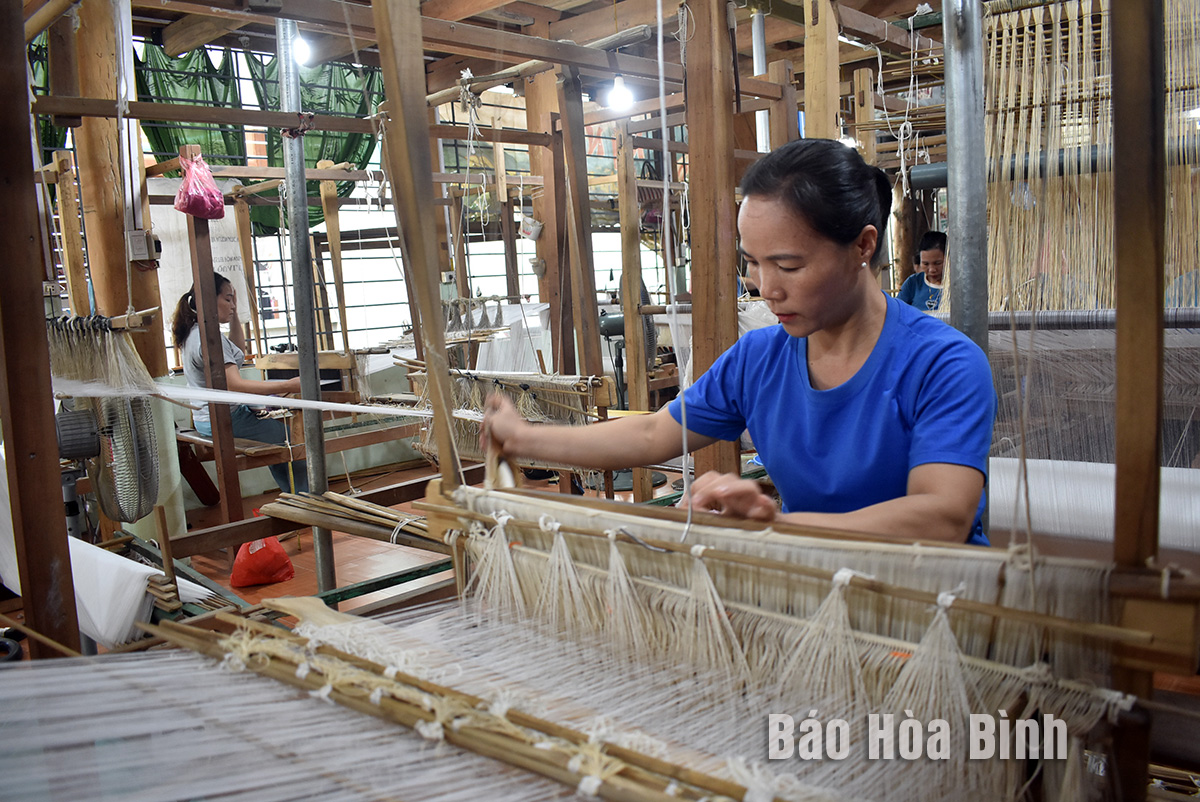
Since its establishment, the Chieng Chau brocade weaving cooperative in Mai Chau district has gathered many members, helping to share experience in the traditional craft and enhance weaving skills among local women, helping to build a brand for the cooperative's products.
joining the Chieng Chau brocade weaving cooperative helps Lo Thi Chanh in Chieng Chau commune have a stable income.
When she was 13 years old, Lo Thi Chanh in Chieng Chau hamlet, Chieng Chau commune, knew how to weave brocade. After getting married, in addition to farming, she did weaving at home and sold her products to private traders. This craft helps her earn an additional 2 million VND (nearly 79 USD) per month. However, her products did not have a brand name, so their value is not high. joining the cooperative, Chanh learned many more skills from others, and her products have a brand name and are known by more and more customers.
Vi Thi Oanh, Deputy Director of the Chieng Chau brocade weaving cooperative, said it has 21 official members and 40 unofficial members who participate in production when there are orders. This craft is suitable for women in mountainous areas during the agricultural off-season.
To expand and diversify income sources, the cooperative has planted mulberry trees and breeding silkworms to serve tourists, she said, adding that the cooperative aims to design many new products that align with consumers’ demand and bring them to domestic and international markets.
Not only producing based on orders, the Hoa Ban cooperative in Lac village, Chieng Chau commune, has also created its own designed products and operated a traditional craft store.
Vi Thi Thuan, Director of the Hoa Ban cooperative, said since its establishment, it has provided regular employment for local women.
Despite being newly established, the cooperative has 17 members and 8 affiliated households, Thuan said, noting that it has continued to diversify products to meet customers’ demand and increase incomes for its members.
For many years, the Luong Phu Agricultural Services Cooperative in Phong Phu commune of Tan Lac district has still persevered with handicrafts. It has also received numerous orders from abroad, ensuring regular jobs for its members.
Bui Thi Quynh in Muong Lo hamlet said after joining the cooperative, she earns from 5-6 million VND per month.
According to Director of the cooperative Nguyen Thi Bay, the establishment creates jobs for 600 workers, with 90% of them being ethnic minority people.
In the coming time, the cooperative will continue to link with units to seek more orders, helping its members have more jobs and increase their income, she added.
With an increasingly vibrant and widespread emulation movement aimed at building cultured residential areas and cultured families, Yen Thuy District has been making steady progress toward improving both the material and spiritual well-being of its people, while fostering a civilized, prosperous, beautiful, and progressive community.
Once lacking recreational spaces and community facilities, Residential Group 2 in Quynh Lam Ward (Hoa Binh City) has recently received attention for the construction of a new, spacious, and fully equipped cultural house. The project followed the model of state support combined with public contributions in both labor and funding.
The "All people unite to build cultural life" movement, which has been effectively integrated with Kim Boi district’s socio-economic development goals, is fostering a lively spirit of emulation across local residential areas, hamlets, villages, public agencies, and enterprises. In addition, through the initiative, traditional cultural values are being preserved and promoted, while community solidarity and mutual support in poverty reduction and economic development are being strengthened.
A working delegation of the Hoa Binh provincial People’s Committee led by its Permanent Vice Chairman Nguyen Van Toan on June 11 inspected the progress of a project to build the Mo Muong Cultural Heritage Conservation Space linked to tourism services in Hop Phong commune, Cao Phong district.
Born and growing in the heroic land of Muong Dong, Dinh Thi Kieu Dung, a resident in Bo town of Kim Boi district, in her childhood was nurtured by the sweet lullabies of her grandmother and mother. These melodies deeply imprinted on her soul, becoming an inseparable part of her love for her ethnic group's culture. For over 20 years, this love for her hometown has driven Dung to research, collect, and pass down the cultural values of the Muong people to future generations.
In the final days of May, the Ethnic Art Troupe of Hoa Binh Province organized performances to serve the people in remote, mountainous, and particularly disadvantaged areas within the province. These were not just ordinary artistic shows, but they were the meaningful journeys aimed at spreading cultural values, enhancing the spiritual life of the people and contributing to the preservation of ethnic minority cultural identities.



